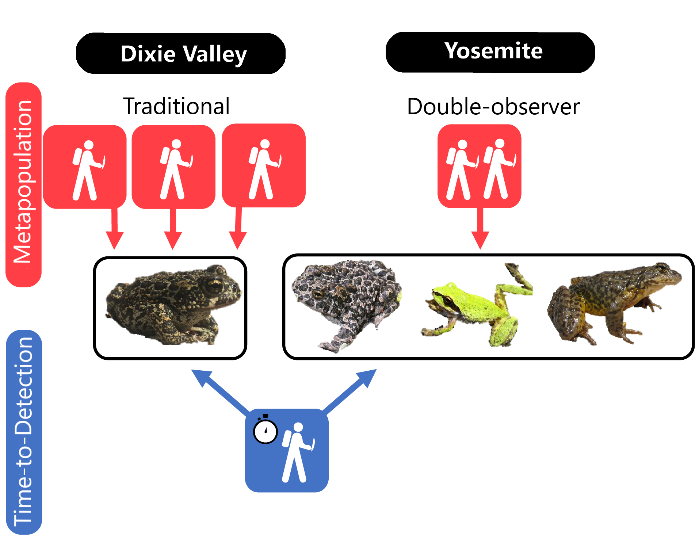Time-to-detection occupancy methods: performance and utility for improving efficiency of surveys
Abstract/Summary
Occupancy methods propelled the quantitative study of species distributions forward by separating the observation process, or the imperfect detectability of species, from the ecological processes of interest governing species distributions. Occupancy studies come at a cost, however: the collection of additional data to account for nondetections at sites where the species is present. The most common occupancy designs (repeated measures designs) require repeat visits to sites or the use of multiple observers or detection methods. Time-to-detection methods have been identified as a potentially efficient alternative, requiring only one visit to each site by a single observer. A comparison of time-to-detection methods to repeated measures designs for visual encounter surveys would allow researchers to evaluate whether time-to-detection methods might be appropriate for their study system and can inform optimal survey design. We collected time-to-detection data during two different repeated measures design occupancy surveys for four amphibians and compared the performance of time-to-detection methods to the other designs using the location (potential bias) and precision of posterior distributions for occurrence parameters. We further used results of time-to-detection surveys to optimize survey design. Time-to-detection methods performed best for species that are widespread and have high detection probabilities and rates, but performed less well for cryptic species with lower probability of occurrence or whose detection was strongly affected by survey conditions. In all cases single surveys were most efficient in terms of person-hours expended, but under some conditions the survey duration required to achieve high detection probabilities would be prohibitively long for a single survey. Regardless of occupancy survey design, time-to-detection methods provide important information that can be used to optimize surveys, allowing researchers and resource managers to efficiently achieve monitoring and conservation goals. Collecting time-to-detection data while conducting repeated measures occupancy surveys requires only small modifications to field methods but could have large benefits in terms of time spent surveying in the long-term.
Publication details
| Published Date: | 2020-11-25 |
| Outlet/Publisher: | Ecological Applications |
| Media Format: | URL |
ARMI Organizational Units:
Southwest, Northern California - BiologyTopics:
Monitoring and Population EcologyQuantitative Developments
Place Names:
CaliforniaNevada
Keywords:
ARMIdetection probability
methods
monitoring
occupancy

